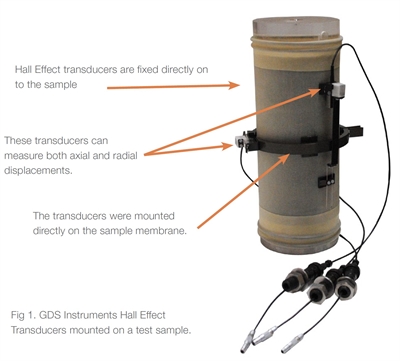Geoteko, Hall Effect Local Strain Transducers
GEOTEKO is a group of companies offering complex geotechnical solutions (laboratory and field testing, consultations, project design and geotechnical monitoring). GEOTEKO has over 25 years of experience working on over 5000 projects for example KGHM Polska Miedz S.A., ORLEN S.A., Metro Warszawskie, ARUP, ARCADIS, HOCHTIEF, KELLER, AARSLEFF, MENARD, BUDIMEX. GEOTEKO has taken part in road, railway, hydrotechnical, housing, energy, mining, environmental and landfill projects. GEOTEKO’S activities include:
- Laboratory soil testing.
- Numerical modelling and geotechnical design.
- Field testing.
- Consultancy and training.
- Monitoring.
Read below or Click here to download the case study
THE PROBLEM
GEOTEKO were required to carry out a series of triaxial tests for one of its clients to assess the samples susceptibility to liquefaction. The void ratio is one of the most important factors that affect the liquefaction phenomenon, therefore
|
the exact determination of this parameter is very important for such tests. It is necessary to monitor the samples void ratio changes at each stage of the test.
|
SOLUTION
Using the standard triaxial instrumentation, it was not possible to monitor the geometry of the sample during the filling of the triaxial cell with water and during the saturation stage. Therefore, void ratio changes at these stages were not registered. GEOTEKO decided to use local displacement transducers from GDS Instruments that mount directly on a sample in the triaxial cell. These transducers can measure both axial and radial displacements. GDS’ Hall Effect Transducers were very light and easy to handle, which was essential given the samples being tested were particularly susceptible to mechanical structural disturbances.
A radial caliper and two axial transducers made of rigid yet very light metal alloy, were used to place the transducers, see figure 1. As a result, during the installation of the instrumentation on the soil sample and during the test, undesirable deformation of the sample could be avoided. The use of this type of transducer allowed Geoteko to control the geometry changes of the sample to be tested, and hence changes in the porosity index.
|
 |
RESULTS
Figure 2 shows an example of void ratio changes at all stages of the test. One can notice, that the void ratio changes at the saturation stage has a significant effect on its final value. Figure 3 shows the steady-state lines. The plot shows steady-state lines obtained from tests where the void ratio was measured by Hall Effect transducers during all testing stages. In addition, steady state lines were plotted for the values of the void ratio without taking into account changes during the saturation stage. It is clear that without taking into account changes of void ratio during saturation stage, the steady state lines are above those determined from the results of the tests taking into account these changes. It is also noticeable that a much greater coherence of the test results was obtained using Hall Effect transducers.
SUMMARY
The Hall Effect transducers offered by GDS Instruments enabled the void ratio monitoring at each stage of the test. In GEOTEKO’s geotechnical laboratory the soil tests to assess susceptibility of liquefaction are always carried out using these sensors. |
Fig. 2 Void ratio changing during sample preparation, saturation and consolidation stages. |
TESTIMONIAL
“GDS Instruments equipment has been used in GEOTEKO’s accredited laboratory for several years. We have used GDS’ triaxial apparatuses for laboratory testing with our commercial customers as well as for research and development. In GEOTEKO’s laboratory we carry out several hundred triaxial tests each year. We therefore require durable and user-friendly apparatus, which is why we chose GDS. Thanks to the advanced technology in GDS apparatus, we have been able to undertake many interesting and non-standard projects. GEOTEKO still receives technical support and we have the opportunity to exchange our experiences with GDS specialists. The development prospects of the GEOTEKO laboratory are closely related to GDS products.” Wojciech Tymiński, Laboratory Manager, GEOTEKO.
|
Fig. 3 Steady state lines for the three types of soils - with and without void ratio changes monitoring during the saturation stage.
|
Website Link:
GDS’ Polish Agent:
Danuta Czeszek
BIOTECHNIKA PRIM Sp. z o.o.
Transducers Featured in Case Study